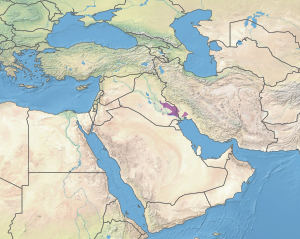美索不达米亚沼泽
美索不达米亚沼泽又称伊拉克沼泽(阿拉伯语:أهوار العراق)或底格里斯-幼发拉底冲积盐沼[3] ,为伊拉克南部与伊朗西南部的湿地[3],包括中部沼泽(由底格里斯河的岔流供水)、哈维则沼泽(伊朗侧由卡赫河供水,伊拉克侧由底格里斯河的岔流供水)与哈马尔沼泽(由幼发拉底河及其支流供水)等三部分[4],曾为欧亚大陆西部最大的湿地生态系统[5],三块沼泽过去在丰水期时水流会交错为一体[4]。
| 美索不达米亚沼泽 底格里斯-幼发拉底冲积盐沼 | |
|---|---|
 沼泽阿拉伯人(马丹人) | |
 美索不达米亚沼泽的位置 | |
| 生态 | |
| 生态带 | 古北界 |
| 生物群系 | 泛滥草甸和泛滥稀林 |
| 相邻地区 | 阿拉伯沙漠, 南伊朗努博·新垫沙漠及半沙漠 and 扎格罗斯山脉森林草原 |
| 地理 | |
| 面积 | 35,572 km2(13,734 sq mi) |
| 国家 | |
| 保护 | |
| 生物保护状况 | 极危/濒危[1] |
| 已保护 | 3,070 km² (9%)[2] |
因地处沙漠,美索不达米亚沼泽为当地少有的水域地景,孕育多种野生动植物,且为沼泽阿拉伯人(马丹人)世居之地。1950年代起伊拉克政府开始抽干美索不达米亚沼泽,将沼泽地转为农用或石油探勘,1980年代晚期至1990年代萨达姆·海珊任内为将信仰什叶派为主的沼泽阿拉伯人驱离此地而加速抽干沼泽的计画,1950年代沼泽阿拉伯人的人数约为50万,抽干沼泽后仅馀约2万人[6]。2003年沼泽面积仅存原本的一成[7],海珊政权倒台后抽干美索不达米亚沼泽的计画停止,部分流落在外的沼泽阿拉伯人陆续迁回[8] ,湿地也缓慢恢复[9],但仍受土耳其、叙利亚与伊朗在当地河流上游构筑水坝拦水的影响[10]。2016年美索不达米亚沼泽获选世界遗产[11]。
生态 编辑
美索不达米亚沼泽的生物群系属泛滥草甸和泛滥稀林[3],湿地中的植物包括芦苇、长苞香蒲与纸莎草等,滨岸林的植被则由胡杨、柽柳与柳树(Salix acmophylla)等组成[1][12]。沼泽中的鸟类约有40种,包括火烈鸟、鹈鹕、美索不达米亚乌鸦(冠小嘴乌鸦的亚种)[13]与多种鹭,以及埃及圣鹮与红蛇鹈等濒危物种[14],过去此处还是自西伯利亚迁徙至非洲的多种候鸟中停的地点,目前全世界约四成至六成的云石斑鸭、以及九成的巴士拉苇莺均栖息于美索不达米亚沼泽中[15]。抽干美索不达米亚沼泽的计画造成严重的生态破坏,至少有印度豪猪、布恩地鼠与狼等7种动物已自此地绝迹[16],欧亚水獭与马克士威江獭(Lutrogale perspicillata maxwelli,江獭的伊拉克亚种)经调查后证实仍存在沼泽中[17]。
参考文献 编辑
- ^ 1.0 1.1 Tigris-Euphrates alluvial salt marsh. 陆地生态区. 世界野生动物基金会., accessed 30 June 2020
- ^ Dinerstein, Eric; Olson, David; et al. An Ecoregion-Based Approach to Protecting Half the Terrestrial Realm. BioScience. June 2017, 67 (6): 534–545. PMC 5451287 . PMID 28608869. doi:10.1093/biosci/bix014 . Supplemental material 2 table S1b.
- ^ 3.0 3.1 3.2 Tigris-Euphrates alluvial salt marsh. 陆地生态区. 世界野生动物基金会.
- ^ 4.0 4.1 Azzam Alwash; Suzanne Alwash; Andrea Cattarossi. Iraq's Marshlands - Demise and the Impending Rebirth of an Ecosystem (PDF). University of Reno, Nevada. [2010-08-07]. (原始内容 (PDF)存档于2011-07-20).
- ^ JACOB SWEET. The Context: Life on the Mesopotamian Marshes—and the Specter of Drought. Harvard Magazine. 2021-07-14 [2021-11-06]. (原始内容存档于2021-07-18).
- ^ ROJAS-BURKE, JOE. IRAQ'S MARSH ARABS, MODERN SUMERIANS. Simply Sharing. May 14, 2003 [7 August 2010]. (原始内容存档于27 May 2011).
- ^ CURTIS J. RICHARDSON AND NAJAH A. HUSSAIN. Restoring the Garden of Eden: An Ecological Assessment of the Marshes of Iraq (PDF). www.biosciencemag.org. June 2006. (原始内容 (PDF)存档于2012-06-06).
- ^ Sorel, Marc A. A Return to Normalcy? The Restoration of Iraq's Marshlands. Foreign Policy Digest. November 2009.
- ^ U.S. National Aeornautics and Space Administration. 2008
- ^ Muir, Jim. Iraq marshes face grave new threat. BBC News. 2009-02-24 [2010-08-07]. (原始内容存档于2021-02-28).
- ^ Iraqi marshlands named as Unesco world heritage site. 2016-07-18 [2021-11-06]. (原始内容存档于2021-08-22).
- ^ {Naval Intelligence Division. Iraq & The Persian Gulf. Routledge. 2014.
- ^ Mespotamian Crow. kuwaitbirds.org,. [2021-11-06]. (原始内容存档于2021-01-24).
- ^ Harper, Nicki. Marsh Arabs of Iraq. Sprol. 2007-03-14 [2010-08-07]. (原始内容存档于2018-12-15).
- ^ Iraq's Marshes Show Progress toward Recovery. Wildlife Extra. [2010-08-07]. (原始内容存档于2010-05-09).
- ^ Askari, Masour. Iraq's Ecological Disaster. International Review. 2003-02-12 [2010-08-07]. (原始内容存档于2021-01-18).
- ^ Al-Sheikhly, O.F.; and Nader, I.A. The Status of the Iraq Smooth-coated Otter Lutrogale perspicillata maxwelli Hayman 1956 and Eurasian Otter Lutra lutra Linnaeus 1758 in Iraq (PDF). IUCN Otter Spec. Group Bull. 2013, 30 (1) [2021-11-06]. (原始内容存档 (PDF)于2017-08-07).